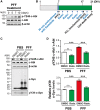The c-Abl inhibitor, Radotinib HCl, is neuroprotective in a preclinical Parkinson's disease mouse model
- PMID: 29897434
- PMCID: PMC6005030
- DOI: 10.1093/hmg/ddy143
The c-Abl inhibitor, Radotinib HCl, is neuroprotective in a preclinical Parkinson's disease mouse model
Abstract
Accumulating evidence suggests that the non-receptor tyrosine kinase c-Abl plays an important role in the progression of Parkinson's disease (PD) and c-Abl inhibition could be neuroprotective in PD and related α-synucleinopathies. Nilotinib, a c-Abl inhibitor, has shown improved motor and cognitive symptoms in PD patients. However, issues concerning blood-brain barrier (BBB) penetration, lack of selectivity and safety still remain. Radotinib HCl is a selective Bcr-Abl kinase inhibitor that not only effectively access the brain, but also exhibits greater pharmacokinetic properties and safety profiles compared to Nilotinib and other c-Abl inhibitors. Here, we show the neuroprotective efficacy of Radotinib HCl, a brain penetrant c-Abl inhibitor, in a pre-clinical model of PD. Importantly, in vitro studies demonstrate that the treatment of Radotinib HCl protects the α-synuclein preformed fibrils (PFF)-induced neuronal toxicity, reduces the α-synuclein PFF-induced Lewy bodies (LB)/Lewy neurites (LN)-like pathology and inhibits the α-synuclein PFF-induced c-Abl activation in primary cortical neurons. Furthermore, administration of Radotinib HCl inhibits c-Abl activation and prevents dopaminergic neuron loss, neuroinflammation and behavioral deficits following α-synuclein PFF-induced toxicity in vivo. Taken together, our findings indicate that Radotinib HCl has beneficial neuroprotective effects in PD and provides an evidence that selective and brain permeable c-Abl inhibitors can be potential therapeutic agents for the treatment of PD and related α-synucleinopathies.
Figures







Similar articles
-
A Novel, Selective c-Abl Inhibitor, Compound 5, Prevents Neurodegeneration in Parkinson's Disease.J Med Chem. 2021 Oct 28;64(20):15091-15110. doi: 10.1021/acs.jmedchem.1c01022. Epub 2021 Sep 28. J Med Chem. 2021. PMID: 34583507
-
Neuroprotective efficacy of a new brain-penetrating C-Abl inhibitor in a murine Parkinson's disease model.PLoS One. 2013 May 31;8(5):e65129. doi: 10.1371/journal.pone.0065129. Print 2013. PLoS One. 2013. PMID: 23741470 Free PMC article.
-
The c-Abl inhibitor, nilotinib, protects dopaminergic neurons in a preclinical animal model of Parkinson's disease.Sci Rep. 2014 May 2;4:4874. doi: 10.1038/srep04874. Sci Rep. 2014. PMID: 24786396 Free PMC article.
-
Parkinson's Disease Modification Through Abl Kinase Inhibition: An Opportunity.Mov Disord. 2022 Jan;37(1):6-15. doi: 10.1002/mds.28858. Epub 2021 Nov 23. Mov Disord. 2022. PMID: 34816484 Free PMC article. Review.
-
C-Abl Inhibition; A Novel Therapeutic Target for Parkinson's Disease.CNS Neurol Disord Drug Targets. 2018 Apr 26;17(1):14-21. doi: 10.2174/1871527316666170602101538. CNS Neurol Disord Drug Targets. 2018. PMID: 28571531 Review.
Cited by
-
c-Abl Phosphorylates MFN2 to Regulate Mitochondrial Morphology in Cells under Endoplasmic Reticulum and Oxidative Stress, Impacting Cell Survival and Neurodegeneration.Antioxidants (Basel). 2023 Nov 16;12(11):2007. doi: 10.3390/antiox12112007. Antioxidants (Basel). 2023. PMID: 38001860 Free PMC article.
-
Radotinib inhibits multiple myeloma cell proliferation via suppression of STAT3 signaling.PLoS One. 2022 May 3;17(5):e0265958. doi: 10.1371/journal.pone.0265958. eCollection 2022. PLoS One. 2022. PMID: 35503759 Free PMC article.
-
Multikinase Abl/DDR/Src Inhibition Produces Optimal Effects for Tyrosine Kinase Inhibition in Neurodegeneration.Drugs R D. 2019 Jun;19(2):149-166. doi: 10.1007/s40268-019-0266-z. Drugs R D. 2019. PMID: 30919310 Free PMC article.
-
The c-Abl inhibitor, radotinib induces apoptosis in multiple myeloma cells via mitochondrial-dependent pathway.Sci Rep. 2021 Jun 24;11(1):13198. doi: 10.1038/s41598-021-92651-9. Sci Rep. 2021. PMID: 34168229 Free PMC article.
-
BrainPhys Neuronal Media Support Physiological Function of Mitochondria in Mouse Primary Neuronal Cultures.Front Mol Neurosci. 2022 Jun 14;15:837448. doi: 10.3389/fnmol.2022.837448. eCollection 2022. Front Mol Neurosci. 2022. PMID: 35774868 Free PMC article.
References
-
- Lang A.E., Lozano A.M. (1998) Parkinson's disease. First of two parts. N. Engl. J. Med., 339, 1044–1053. - PubMed
-
- Lang A.E., Lozano A.M. (1998) Parkinson's disease. Second of two parts. N. Engl. J. Med., 339, 1130–1143. - PubMed
-
- Dawson T.M., Dawson V.L. (2003) Molecular pathways of neurodegeneration in Parkinson's disease. Science, 302, 819–822. - PubMed
-
- Tsang A.H., Chung K.K. (2009) Oxidative and nitrosative stress in Parkinson's disease. Biochim. Biophys. Acta, 1792, 643–650. - PubMed
Publication types
MeSH terms
Substances
Grants and funding
LinkOut - more resources
Full Text Sources
Other Literature Sources
Medical
Miscellaneous

